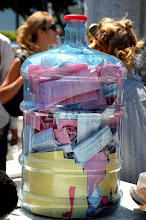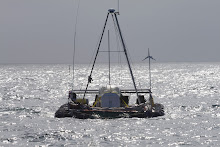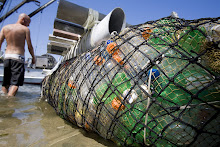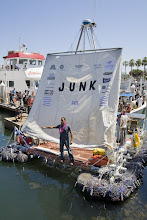JUNK has arrived safely, to a throng of cheering supporters, journalists, and videographers. After a few hours of interviews, the crew headed out for a much deserved lunch of FRESH FOOD and drink.
Photos coming of the arrival as soon as we've all settled into the land reality. Meantime, some final thoughts from Marcus and Joel:
At 1:00 am I took the helm, as Joel climbed into the cabin to sleep after having been on watch for 8 hours. A squall quickly overcame JUNK and left me and the deck drenched. The moon shot out from behind the clouds, illuminating the backside of the storm. By the light of the moon, a complete rainbow appeared. I’ve never seen one at night. I’ve 8 hours to keep the raft on a steady course for Honolulu, which is now only 40 miles away. There is so much to think about, so much to do, but still plenty of time to let my mind wander and ponder on this voyage. It’s been a long summer.
2,600 miles of open ocean crossed in 87 days. From our first week of sinking hopes on a sinking raft, through four hurricanes that swept under us, to the unbelievable chance meeting with Roz Savage in the middle of nowhere, we have had quite an adventure. We’ve collected 10 ocean surface samples using our marine debris trawl, managed to snatch a few large pieces of plastic debris that floated under us, and caught fish with stomachs filled with particles of plastic. Plastic is forever, and it’s everywhere.
That’s been our point. The Synthetic Century should have ended 8 years ago, replaced by the Age of Sustainability. There are over 20,000 man-made chemicals produced by the billions of pounds annually that are dispersed throughout the globe in an open loop of consumption that often ends as waste to be buried, burned or to flow down coastal watersheds out to sea. It is unsustainable and deeply troubling knowing that many synthetic compounds are persistent in the environment and are harmful to wildlife and humans. Plastic marine debris is one of them, and is the most ubiquitous form of pollution visible around the world. It is clear that single-use disposable plastic products have no place in modern society.
We return to society tomorrow if all goes well, to the world of alarm clocks, calendars, cars and shoes. Three months is enough time to forget the world you left and accept a new reality. But not everything is forgotten. I long for my friends, family and fiancée. I crave fresh veggies and exercise. In three months I wonder how I will reflect on this summer? Will there be days when I will find myself wishing to be back on JUNK, even if only for a minute? I don’t know what this experience will bring, but it is my intention to use it as a starting point for hundreds of conversations about solutions to the plastic plague. We have, in half a century, transformed 2/3rds of the ocean surface into a plastic soup. Knowing what I know, it would be immoral to do nothing.
As I watch the sun set on the final day at sea, I am overcome more with humility than excitement. I am truly humbled by the efforts of so many people that have made this journey a reality. Donations of time and funds came pouring in once we committed to this project, and thousands of people followed our story online. From an idea sketched on paper years ago, to the final miles of an amazing adventure, I can only say “Thank you.”
Best wishes,
Marcus
And for Joel's final words, read on:
Land oh! I spotted land this afternoon at 1:45 Hawaii Time. The flanks of Mount Haleakala were showing through the clouds on East Maui. It’s been 85 days since we were towed out of Rainbow Harbor in Long Beach and around two months since sailing away from Isla de Guadalupe, the last piece of land sighted.
Junk was built in Long Beach next to the mouth of the Los Angeles River. Everyday I was there working on Junk the tide would push plastic debris into the harbor and remind me why as doing this. In the 2600 nautical miles since then we have observed all kinds of plastic debris floating and collected in the trawl. We have also watched a small school of fish, rainbow runners, that have been following Junk, grow from small fries with their egg sack attached to juveniles close to a foot in length. They too have traveled through the gyre gathering plastic debris. After catching one of the larger rainbow runners we looked in it’s stomach and found it was full of plastic bits including a pre-production plastic pellet or a nurdle. It gives me a profound sense that there is no place and no life form on earth that isn’t being affected by the on slot of synthetic chemicals that humans are releasing into the environment. It also brings home the point that planetary life support system works in cycles and we eventually learn (usually the hard way) that things we once though were benign directly affect human health and that there is no difference between environmental health and human health.
I am looking forward to being on land, but I’m staying focused on the task at hand, that is safely navigating Junk through the Kaiwi Channel between Molokai and Oahu and into the Ala Wai Harbor. The open ocean has it’s challenges but sailing close to land is often more dangerous. Kalaupapa Peninsula almost wrecked Don McFarland on his rafting voyage from California to Hawaii more than fifty years ago. We trying to stay at least 10 nautical miles north of Kalaupapa but not so far north that we get trapped on the windward side of Oahu and blown into the sea cliffs around Makapu’u. Right now the weather is perfect. We’re making our course dead-on and at this speed we should arrive at Diamond Head around noon.
Malaho for following the Junk Blog!
Joel
/span>
Read more!
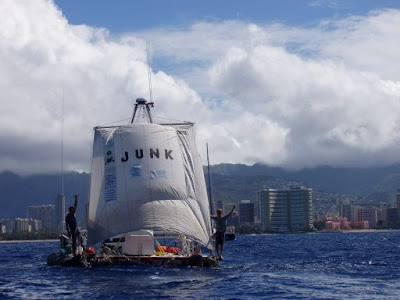
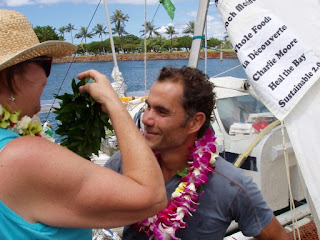 There were perhaps 100 people there to greet us, including plenty of media representatives to cover our story, everyone asking, “Why did you do this,” or “Was it worth it?” If you've been following our blog, you know why. Yes, it was worth it. We would do it again.
There were perhaps 100 people there to greet us, including plenty of media representatives to cover our story, everyone asking, “Why did you do this,” or “Was it worth it?” If you've been following our blog, you know why. Yes, it was worth it. We would do it again.



